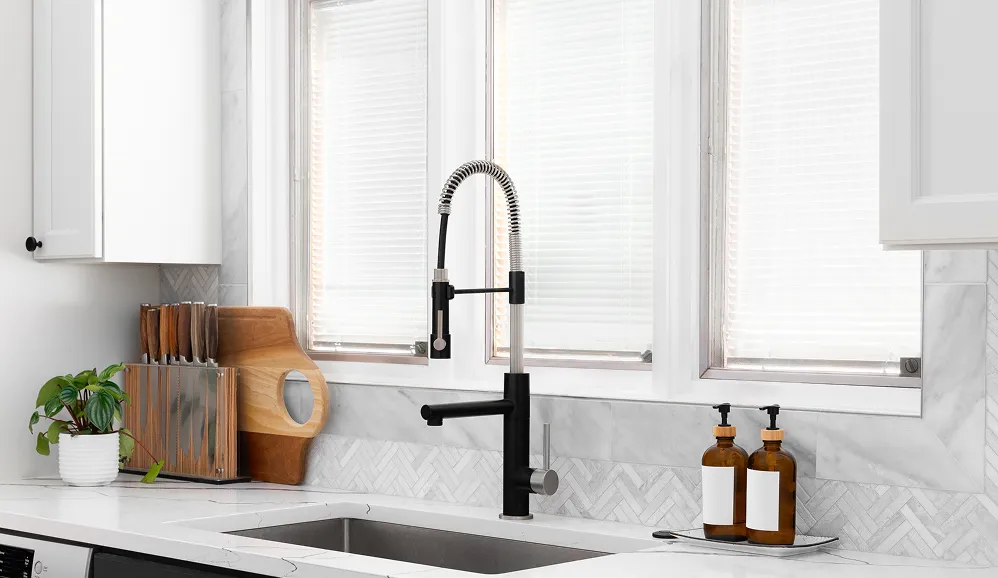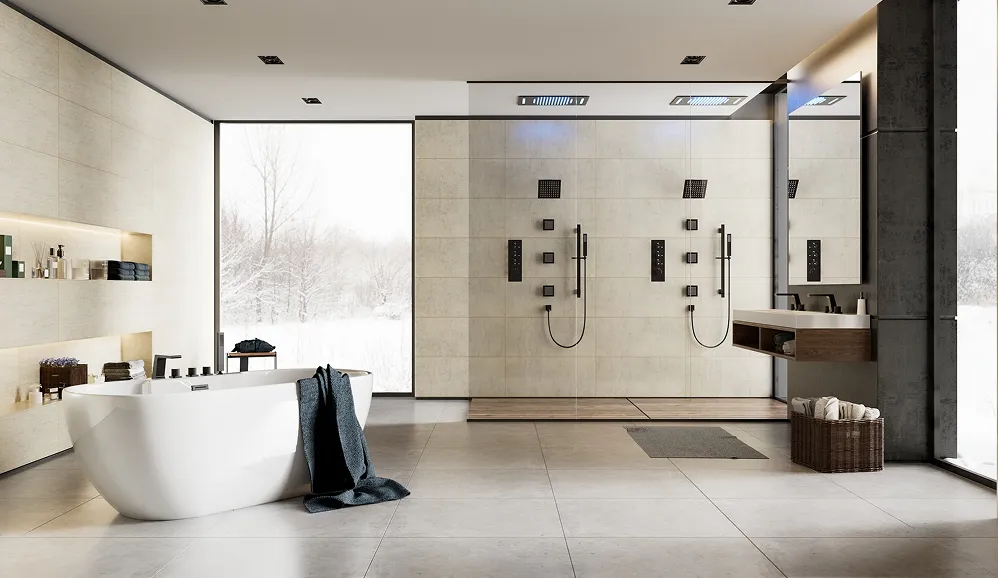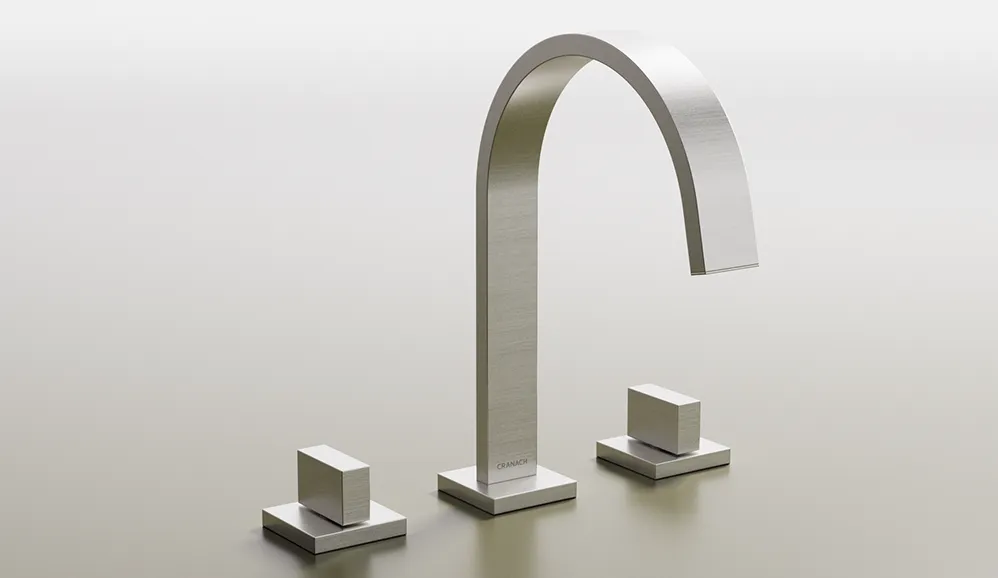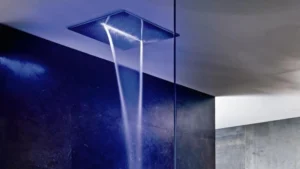The Science Behind Stubborn Faucet Calcium Deposits
Ever noticed those annoying white spots on your faucets? These aren’t just an eyesore. They’re a sign of hard water running through your pipes. This hard water is full of dissolved minerals like calcium and magnesium, which cause the chalky buildup we call limescale.
When water evaporates from your faucet, these dissolved minerals get left behind. They slowly build up and harden into those stubborn deposits. This means that even water that looks clean can contribute to the problem. You might be interested in: How to master…
This process is especially common in areas with naturally hard water. As water moves through the ground, it absorbs minerals like calcium carbonate and calcium bicarbonate. While these minerals are invisible when dissolved, they become very noticeable when they solidify on faucet surfaces.
This buildup isn’t just unattractive. It can affect water pressure and even reduce the life of your fixtures. Calcium deposits, also known as limescale, mainly come from hard water. Hard water contains high levels of dissolved calcium carbonate and calcium bicarbonate salts. These deposits accumulate on faucets and fixtures over time, creating a hard, chalky layer. This layer is not only unsightly but also affects how well your plumbing works. Learn more about this issue here.
Recognizing the Early Warning Signs
It’s important to spot calcium buildup early to avoid bigger problems. You might first see a slight discoloration or a cloudy film on your faucet.
Water flow can also become uneven or weaker as deposits start to block the aerator. While these early signs might seem small, they point to a growing issue that needs attention.
The Chemistry of Calcium Deposits
The change from dissolved minerals to solid deposits is a fascinating chemical reaction. When water evaporates, the concentration of calcium and magnesium ions increases.
This higher concentration pushes the dissolved minerals past their saturation point. This forces them to come out of the water and onto your faucet. The speed of this process depends on things like water temperature and pH.
Hot water, for example, makes evaporation happen faster, leading to quicker deposit formation. This is why hot water faucets often have more limescale buildup. The type of metal in your faucet can also affect how well the deposits stick and how visible they are.
The Hidden Cost of Ignoring Your Faucet’s Calcium Buildup
Those white spots around your faucet aren’t just an eyesore. They’re a warning sign of a hidden cost that could be impacting your wallet. Many homeowners overlook the surprising financial consequences of calcium deposits. These mineral buildups affect everything from water flow to the lifespan of your fixtures, ultimately leading to higher expenses down the line. For a better understanding of water flow, you can learn more about water flow rates.
Restricted Water Flow and Higher Bills
One of the most immediate consequences of calcium buildup is restricted water flow. As these mineral deposits accumulate, they constrict your pipes and clog aerators. This reduces water volume, forcing you to run the water longer for everyday tasks like washing dishes or even filling a pot. The result? A noticeable increase in your water bills. Plumbing experts report that substantial calcium buildup can decrease water flow rates by up to 30%, directly translating into higher water consumption and, consequently, increased costs. Learn more about why your faucets have calcium deposits.
Increased Energy Consumption
Calcium buildup doesn’t just affect your faucets. It also impacts your water heater’s efficiency. The accumulated minerals act as insulation, preventing the heating element from effectively transferring heat to the water. This means your water heater has to work harder and longer to reach the desired temperature, consuming more energy and driving up your utility bills. This added cost can be significant over time, especially for households with high hot water demand.
Premature Fixture Replacement
The constant presence of calcium deposits also takes a toll on the lifespan of your fixtures. Over time, these minerals corrode the finish and can even damage internal components. This leads to leaks, reduced functionality, and ultimately, the need for premature replacement. Replacing faucets and other fixtures can be a considerable expense, especially if multiple fixtures are affected.
Quantifying the Costs
To understand the cumulative financial impact, let’s consider a hypothetical scenario. A household with a 30% reduction in water flow due to calcium buildup could see a 10-15% increase in their monthly water bill. Add to that a 10% increase in energy costs due to a less efficient water heater, and the total cost becomes substantial. Finally, factor in the premature replacement of a faucet every few years, instead of its expected lifespan, which can add hundreds of dollars to your home maintenance expenses.
To illustrate the potential financial impact further, let’s look at the table below:
Financial Impact of Calcium Deposits
Compares how calcium deposits affect different aspects of home maintenance costs
| Impact Area | Consequence | Potential Cost Increase |
|---|---|---|
| Water Flow | Reduced water flow, requiring longer running times | 10-15% increase in monthly water bill |
| Water Heater Efficiency | Reduced efficiency due to mineral insulation | 10% increase in monthly energy bill |
| Fixture Lifespan | Corrosion and damage leading to premature replacement | Hundreds of dollars per fixture over several years |
As the table demonstrates, ignoring calcium buildup can result in a significant increase in household expenses.
Addressing calcium buildup proactively, through regular cleaning and prevention methods, can save you a considerable amount of money in the long run. Taking simple steps to mitigate these issues can help protect your plumbing system and keep your household budget in check.
Vinegar: Your Kitchen’s Secret Weapon Against Calcium
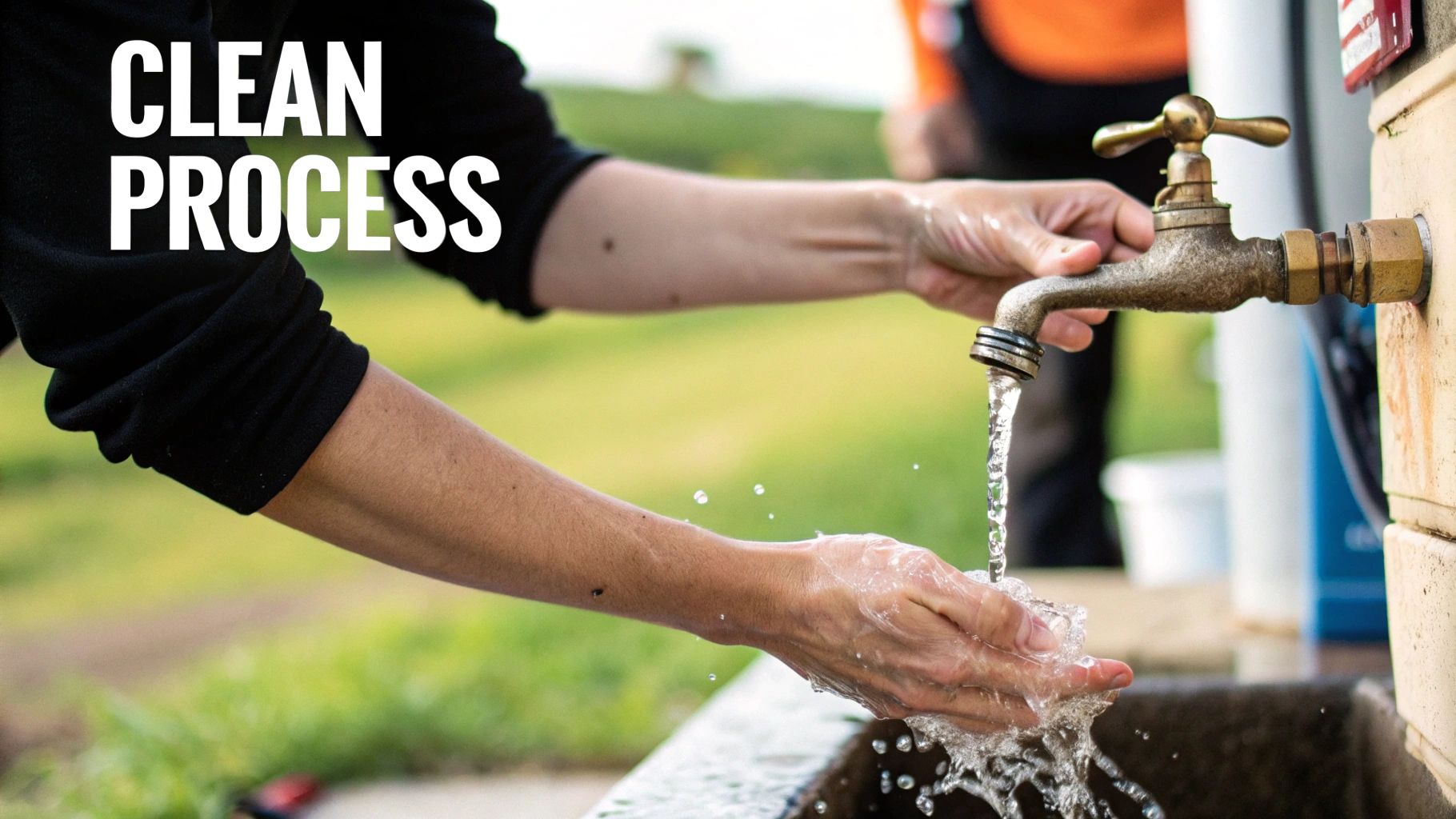
Dealing with calcium buildup on your faucets can be a real headache. But before you rush out and buy expensive cleaning products, consider a simple, cost-effective solution already in your pantry: vinegar. This common kitchen staple is surprisingly powerful at removing those pesky calcium deposits.
Household vinegar, readily available at any grocery store, is incredibly effective in tackling this common problem. Considering that hard water affects approximately 85% of households in the United States, calcium buildup is a frequent issue. Explore this topic further. Vinegar is a must-have for keeping your faucets clean and functioning efficiently. Check out our product categories for more helpful cleaning solutions.
The Science of Vinegar’s Effectiveness
The secret to vinegar’s cleaning power lies in its acetic acid content. This acid reacts with the calcium carbonate present in the deposits, breaking them down and making them easy to wipe away. Think of it like dissolving sugar in water – the vinegar acts in a similar way, but on calcium buildup.
This chemical reaction effectively removes the unsightly deposits without harming most faucet materials. This makes vinegar a safe and practical cleaning solution. As a bonus, vinegar is a natural, non-toxic cleaner, a perfect choice for environmentally conscious homeowners.
Applying Vinegar to Different Faucet Types
How you apply vinegar depends on your faucet type. For faucets with removable aerators, soaking the aerator in vinegar provides the most direct and effective cleaning.
-
Removable Aerators: Disassemble your aerator and soak it in a bowl of undiluted white vinegar. A soak of at least 30 minutes is recommended, or even overnight for stubborn deposits.
-
Fixed Fixtures: If your aerator is fixed, create a vinegar wrap. Soak a cloth or paper towel in vinegar and secure it around the affected area with a rubber band. Leave this wrap in place for a few hours, or overnight for heavier buildup.
Timing and Concentration
The amount of time you need to let the vinegar work its magic depends on the severity of the calcium deposits. For light buildup, 30 minutes to an hour might suffice. Heavier deposits may require several hours or overnight soaking.
While regular household vinegar works effectively, a higher concentration, such as cleaning vinegar, can speed up the process for heavily encrusted faucets. However, always test a small, inconspicuous area first to ensure it doesn’t damage your faucet’s finish.
Safety and Precautions
While vinegar is generally safe to use, taking a few precautions is always a good idea. Ensure proper ventilation when using vinegar, as the fumes can be quite strong.
For delicate finishes like brushed nickel or gold, dilute the vinegar with water to avoid any potential damage. This preventative measure ensures your faucet’s finish remains pristine while effectively tackling calcium deposits. For particularly stubborn calcium deposits that vinegar alone can’t handle, explore the additional cleaning solutions discussed in the next section.
Beyond Vinegar: Premium Solutions for Stubborn Deposits
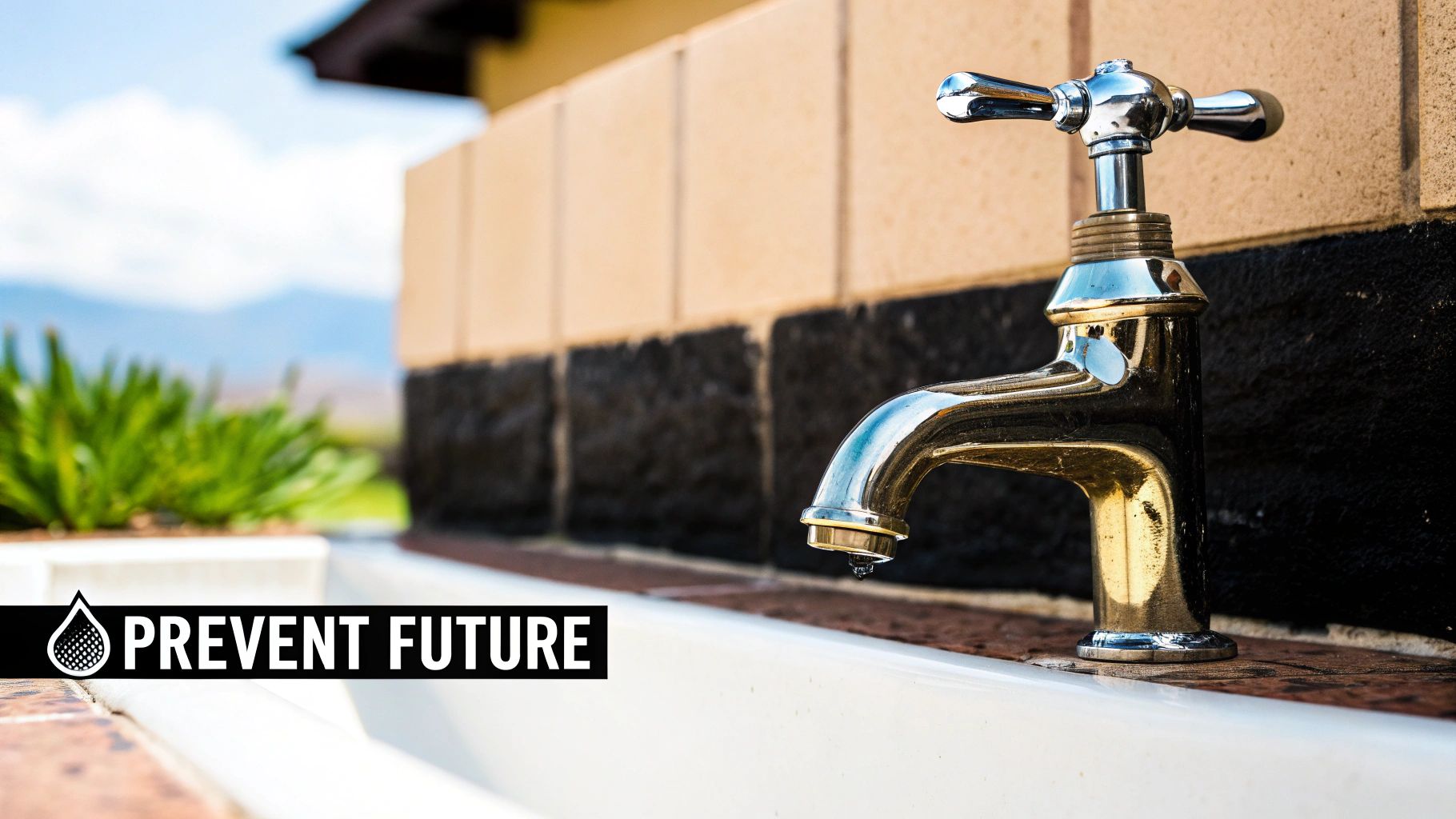
While vinegar is a popular choice, sometimes you need more than a simple vinegar soak to tackle those stubborn calcium deposits on your faucets. Years of mineral buildup can leave unsightly white or chalky scales. Vinegar’s acetic acid works by breaking down the calcium carbonate, dissolving these deposits. Soaking faucet parts in white vinegar for a few hours, or wrapping a vinegar-soaked cloth around the faucet, can be effective for lighter buildup. This method is both budget-friendly and environmentally sound, avoiding harsh chemicals. Discover more insights about removing calcium buildup.
But what if vinegar isn’t quite cutting it?
Natural Alternatives
Lemon juice, thanks to its citric acid, offers similar cleaning power to vinegar, but with a more pleasant scent. This makes it a great choice for decorative fixtures where vinegar’s strong odor might be unwelcome. Simply apply lemon juice to the affected area, let it sit for about an hour, then scrub and rinse.
Baking soda is another natural cleaning powerhouse. Make a paste with baking soda and water, apply to the calcium deposits, and let it sit. The baking soda’s gentle abrasive action, along with its alkaline properties, helps loosen and lift the mineral buildup.
Commercial Descalers
For the toughest calcium deposits, commercial descalers offer a heavy-duty solution. These products are designed to quickly and efficiently dissolve calcium and other mineral buildup. However, it’s essential to choose a descaler that’s compatible with your faucet’s material. Some descalers can damage delicate finishes like brushed nickel or gold. Always follow the manufacturer’s instructions and test on a small, hidden area first to prevent any unwanted damage.
Specialized Approaches for Different Faucet Materials
Different faucet materials require different cleaning strategies. Brass and chrome can generally handle stronger cleaning solutions, while brushed nickel needs a gentler approach.
-
Brass and Chrome: These robust materials can typically tolerate commercial descalers or more concentrated vinegar solutions.
-
Brushed Nickel: Opt for diluted vinegar or lemon juice to avoid damaging the finish. Steer clear of abrasive cleaners or scrubbing pads, as these can scratch the surface.
Comparing Cleaning Solutions
To help you choose the best method for your needs, we’ve put together a comparison table outlining the effectiveness, cost, environmental impact, and ideal uses of each cleaning solution.
Calcium Deposit Removal Methods Comparison: This table compares different cleaning solutions for removing calcium deposits from faucets.
| Cleaning Method | Effectiveness | Cost | Environmental Impact | Best For |
|---|---|---|---|---|
| White Vinegar | Moderate to High | Low | Low | General cleaning, removable parts |
| Lemon Juice | Moderate | Low | Low | Decorative fixtures, light buildup |
| Baking Soda | Moderate | Low | Low | Gentle cleaning, light buildup |
| Commercial Descalers | High | Moderate to High | Varies | Stubborn deposits, quick results |
As you can see, each method has its own strengths and weaknesses. Choosing the right solution depends on the severity of the calcium buildup and the material of your faucet.
By understanding the specific needs of your faucet and the extent of the mineral deposits, you can select the most effective and safest cleaning method. This will help you restore your fixtures to their original shine. Remember to always prioritize safety and follow product instructions.
Master Class: Removing Calcium Deposits Like a Pro
You’ve learned about the damage calcium deposits can cause and how effective vinegar can be in removing them. Now, let’s explore a professional approach to restoring your faucets to their original shine. This comprehensive guide, developed with insights from experienced plumbers, covers every step, from initial preparation to tackling the most stubborn buildup.
Preparing Your Workspace
Before you begin, proper preparation is essential for protecting your surfaces and ensuring your safety. First, spread old towels or newspapers around the faucet area to catch any spills. Next, put on rubber gloves to protect your hands from the cleaning solution. Finally, if your faucet has removable parts, such as aerators, carefully disassemble them before starting the cleaning process. For more information on different faucet finishes, check out this resource: How to master different faucet finishes…
Targeting Different Faucet Components
Different parts of your faucet require specific cleaning approaches.
- Aerators: Soaking is often the most effective method. Submerge the aerator in undiluted white vinegar for at least 30 minutes, or overnight for particularly stubborn deposits.
- Handles and Fixed Components: A vinegar wrap works wonders. Soak a cloth or paper towel in vinegar, wrap it tightly around the affected area, and secure it with a rubber band. Let it sit for a few hours, or overnight for heavy buildup.
Lemon juice, with its citric acid, is a great alternative, especially for chrome, copper, or brass faucets. It offers similar cleaning power to vinegar with a more pleasant scent. Regular aerator cleaning and drying your faucet after each use can significantly reduce future limescale. Learn more about removing calcium buildup from this helpful resource: Learn more about removing calcium buildup here.
Material-Specific Techniques
Different faucet materials react differently to cleaning solutions.
- Chrome, Brass, and Stainless Steel: Vinegar is generally safe and effective.
- Specialty Finishes (Gold Plating, Brushed Nickel): It’s crucial to test any cleaning solution on a small, inconspicuous area first. Diluting vinegar with water is often recommended for these delicate finishes to minimize the risk of damage.
Addressing Common Challenges
Reaching recessed areas or tackling heavy buildup can be tricky. A toothbrush or small cleaning brush dipped in vinegar can help scrub away deposits in hard-to-reach spots. For severely hardened buildup, repeated vinegar applications or a paste of baking soda and water can loosen the deposits before scrubbing.
Evaluating Your Progress
How do you know when all the calcium has been removed? A shiny, clean surface free of any white, chalky residue is the clearest sign. Improved water flow, particularly if the aerator was clogged, also indicates success. Look for a strong, even stream of water. Finally, regular inspection for any signs of recurring buildup is key to maintaining sparkling clean faucets and preventing future issues.
Winning the War Against Future Calcium Deposits
Now that your faucets shine, let’s talk about keeping them that way. This guide outlines a strategy for preventing calcium deposits and maintaining pristine fixtures. Less scrubbing, more enjoying!
Simple Daily Habits
Preventing calcium buildup can be as easy as adopting a few simple daily habits. A quick 30-second wipe down after each use can significantly reduce limescale. This removes water before it evaporates and leaves mineral deposits. Drying with a soft cloth adds extra protection. Two simple steps, big difference.
Water Treatment Options
Beyond daily habits, several water treatment solutions combat hard water and prevent calcium deposits, from budget-friendly options to whole-house systems.
-
Faucet Aerator Filters: These inexpensive filters attach to your faucet and remove sediment and some minerals before they reach your faucet. This can significantly reduce calcium buildup and improve water quality.
-
Water Softening Systems: These systems use ion exchange technology to replace calcium and magnesium ions with sodium ions. This “softens” the water, preventing mineral deposits. More expensive than aerator filters, they offer a whole-house solution.
You might be interested in: Exploring different categories related to home improvement.
Choosing the Right Solution
The ideal solution depends on factors like water hardness, home size, and budget. For moderately hard water, faucet aerator filters or showerhead filters may suffice. For very hard water, a whole-house water softener might be a better investment. Consider the environmental impact of filter disposal and explore alternatives to ensure responsible disposal, as discussed in this article about reusing plastic takeout containers.
Understanding Ion Exchange Technology
Water softeners use ion exchange to remove calcium and magnesium. Imagine tiny, negatively charged beads inside the softener. They attract the positively charged calcium and magnesium ions, trapping them. They then release sodium ions, which are harmless and don’t cause limescale. This removes the minerals responsible for calcium deposits, leaving you with softer water.
Cost-Benefit Analysis
While water softeners have a higher upfront cost, they offer long-term savings. By preventing calcium buildup, they extend the lifespan of your plumbing fixtures, reduce the need for cleaning products, and can even lower your water and energy bills.
For instance, in a house with very hard water, a water softener can pay for itself within a few years by reducing fixture replacements and water heating costs.
Real Household Examples
Consider a family in Arizona, a region known for hard water, who constantly battled calcium buildup. After installing a water softener, they noticed a dramatic decrease in limescale, resulting in less cleaning and longer-lasting fixtures. This illustrates the tangible benefits of water treatment.
By combining simple daily habits with the right water treatment solution, you can win the war against future calcium deposits. This proactive approach protects your fixtures and saves you time and money.
Ready for pristine, calcium-free fixtures? Explore Cranach’s high-quality faucets designed for style and durability. Visit Cranach bath and kitchen today and find the perfect faucet for your home.


